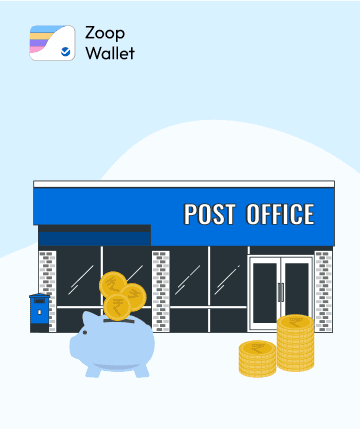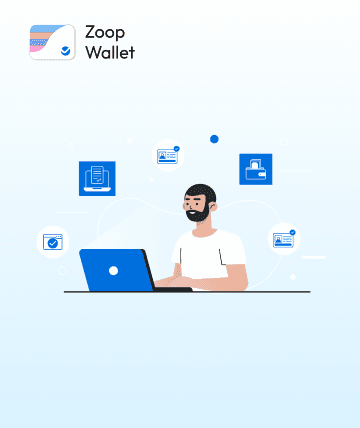Fraud & News
Sep 17, 2024
25 most common cyber attacks ( how to prevent it ) 2024-25
Geetika Panwar
Content Writer
The cybersecurity landscape is constantly evolving as businesses and individuals face an increasing number of cyber threats. With the rise in cyberattacks such as phishing, ransomware, and data breaches, protecting sensitive information has never been more critical. Common cybersecurity threats include identity theft, malware infections, and hacking attempts aimed at stealing personal or financial data.
One way to safeguard your sensitive documents from cyberattacks is through secure tools like a Document Wallet App. A solution like Zoop Wallet not only provides secure document management but also offers protection against various cyber security threats by keeping your documents encrypted and safe from unauthorized access.
What Are Cyber Attacks?
Cyberattacks are malicious attempts by individuals or groups to access, disrupt, or steal data from computer systems, networks, or devices. These attacks often aim to exploit vulnerabilities in systems to gain unauthorized access to sensitive information, causing financial and reputational damage. Cyberattacks can take many forms, including phishing, ransomware, and malware infections, each posing serious cybersecurity threats to individuals and businesses alike.
Why Awareness is Crucial to Protect Against Cybersecurity Attacks
Awareness of cyber threats is the first line of defence in protecting against cyber security threats. Understanding the risks, recognizing common cyberattacks, and knowing how to respond can significantly reduce the chances of falling victim to these attacks. Being informed empowers individuals and organizations to take proactive steps to secure their systems and protect sensitive data.
25 Most Common Cyber Attacks & Prevention
Here safeguard your digital world with 25 most common Cyber Attacks and How to Prevent Them -
1. Phishing Attacks
Phishing is a cyber attack where attackers send fraudulent emails or messages disguised as legitimate sources to steal sensitive information such as login credentials or financial data. According to reports, 90% of cybersecurity threats begin with a phishing email, making it one of the most common cyber threats.
Prevention Tips:
Implement email filters to block suspicious or malicious emails.
Conduct regular awareness training for employees to help them recognize phishing attempts.
2. Ransomware
Ransomware is a type of cyberattack where malicious software locks or encrypts a victim's data, demanding a ransom for its release. These attacks can cripple businesses and lead to significant financial losses. In 2021, ransomware caused an estimated $20 billion in damages worldwide.
Prevention Tips:
Regularly back up important data to prevent data loss in case of an attack.
Install and maintain updated antivirus software to detect and block ransomware before it executes.
3. Malware
Types of Malware:
Viruses: Spread by attaching to legitimate programs or files.
Worms: Self-replicating malware that spreads without human intervention.
Trojans: Malware disguised as harmless software that gives attackers unauthorized access.
Prevention Tips:
Use firewalls to monitor and block suspicious network activity.
Install and regularly update security software to protect against various types of malware.
4. Denial-of-Service (DoS) Attacks
A DoS (Denial-of-Service) attack aims to overwhelm a network, server, or website with excessive traffic, rendering it unavailable to legitimate users. A DDoS (Distributed Denial-of-Service) attack amplifies this by using multiple compromised systems to launch the attack.
Prevention Tips:
Implement network redundancy to distribute traffic across multiple servers.
Use network monitoring tools to detect unusual traffic and prevent attacks before they cause damage.
5. Man-in-the-Middle (MitM) Attacks
In a Man-in-the-Middle (MitM) attack, a hacker intercepts communication between two parties to steal or manipulate information. Common examples include eavesdropping on unsecured Wi-Fi networks or intercepting login credentials during online transactions.
Prevention Tips:
Always use encryption for sensitive communications.
Ensure secure connections by using SSL/TLS certificates for websites.
6. SQL Injection
An SQL Injection occurs when attackers exploit vulnerabilities in a web application’s database by inserting malicious SQL code, allowing them to access or manipulate sensitive data. SQL injection is one of the most common web-based cyber security threats.
Prevention Tips:
Implement input validation to prevent unauthorized SQL code from being executed.
Use parameterized queries to ensure user inputs are treated as data rather than executable code.
7. Credential Stuffing
In credential stuffing, attackers use stolen usernames and passwords from one service to gain access to multiple accounts, assuming users often reuse credentials. This attack takes advantage of large-scale data breaches.
Prevention Tips:
Use unique passwords for different accounts to reduce the risk of credential reuse.
Enable two-factor authentication (2FA) to add an extra layer of security beyond just passwords.
8. Social Engineering
Social engineering involves tricking individuals into divulging confidential information through manipulation, often via phone, email, or even in person. Techniques include phishing, pretexting, and baiting.
Prevention Tips:
Conduct regular employee training to raise awareness of social engineering techniques.
Encourage employees to verify identities before sharing sensitive information
9. Insider Threats
Types of Insider Threats:
Malicious insiders: Employees or contractors who intentionally misuse access to steal or sabotage.
Negligent insiders: Individuals who unintentionally cause harm through careless actions or oversight.
Prevention Tips:
Implement access controls to limit the data that employees can access.
Use continuous monitoring to detect suspicious activity or policy violations.
10. Zero-Day Exploits
A zero-day exploit targets software vulnerabilities that are unknown to the vendor and for which no patch has been released. These attacks are highly dangerous because there is no immediate defense against them.
Prevention Tips:
Keep systems and software updated with the latest patches.
Implement intrusion detection systems to identify signs of zero-day exploitation.
11. IoT Attacks
Risks Associated with IoT Devices:
Internet of Things (IoT) devices are often vulnerable to cyberattacks due to weak security configurations. These devices can be compromised to steal data or disrupt services.
Prevention Tips:
Ensure secure configurations by changing default passwords and updating firmware.
Use network segmentation to isolate IoT devices from critical systems.
12. Drive-By Downloads
In drive-by download attacks, malicious software is automatically downloaded onto a user’s device when they visit an infected website, without the user's knowledge.
Prevention Tips:
Adjust browser security settings to block unauthorized downloads.
Install and regularly update antivirus software to detect and prevent these cyber threats.
13. Credential Harvesting
Credential harvesting involves cybercriminals using phishing emails, fake websites, or malware to collect login credentials, leading to unauthorized access to sensitive systems.
Prevention Tips:
Educate users about phishing and cybersecurity threats.
Implement secure login practices like two-factor authentication (2FA).
14. Ad Fraud
Ad fraud involves fraudulent activity in digital advertising, such as generating fake clicks or impressions, which costs businesses millions in wasted marketing budgets.
Prevention Tips:
Regularly monitor ad performance and traffic sources.
Use fraud detection tools to identify and block malicious activity.
15. Domain Spoofing
In domain spoofing, attackers impersonate legitimate websites or domains to trick users into revealing personal information or spreading malware.
Prevention Tips:
Implement domain monitoring to detect unauthorized use.
Use DMARC (Domain-based Message Authentication, Reporting, and Conformance) to verify email sender identities.
16. ATM Skimming
ATM skimming involves attaching devices to ATMs to capture card details and PINs, which are later used for fraudulent transactions.
Prevention Tips:
Use secure ATMs in well-monitored areas.
Be vigilant for any unusual devices on ATMs.
17. Eavesdropping Attacks
In eavesdropping attacks, attackers intercept private communications, often over unencrypted networks, to steal sensitive data.
Prevention Tips:
Always use encrypted communications like HTTPS for websites and VPNs for secure browsing.
18. Rogue Software
Rogue software pretends to be legitimate but is designed to damage or steal data from a user's device, often spreading malware or performing unauthorized actions.
Prevention Tips:
Only download software from trusted sources and avoid unofficial websites.
19. Supply Chain Attacks
Supply chain attacks target a business's suppliers or partners to gain unauthorized access to sensitive information or infrastructure.
Prevention Tips:
Conduct thorough vendor assessments to ensure partners follow strict security protocols.
Continuously monitor the supply chain for potential threats.
20. Web Application Attacks
Common cyberattacks on web applications include SQL injection, cross-site scripting (XSS), and denial-of-service (DoS) attacks, which exploit vulnerabilities in web systems.
Prevention Tips:
Perform regular security testing and updates to address vulnerabilities in web applications.
21. Credential Reuse
In credential reuse, attackers exploit users who reuse the same login credentials across multiple sites, using stolen information to breach multiple accounts.
Prevention Tips:
Use password managers to generate and store unique passwords.
Enable two-factor authentication for additional protection.
22. Data Breaches
A data breach occurs when sensitive information is accessed by unauthorized individuals, leading to identity theft or financial loss.
Prevention Tips:
Implement data encryption to protect sensitive information.
Use access controls to restrict unauthorized users from sensitive data.
23. Clickjacking
Clickjacking is a malicious technique where attackers trick users into clicking on something different from what they perceive, leading to compromised systems or information theft.
Prevention Tips:
Use frame-busting techniques to prevent attackers from embedding your website in malicious frames.
24. Cryptojacking
In cryptojacking, cybercriminals use your device's processing power to mine cryptocurrency without your consent, often slowing down your systems.
Prevention Tips:
Monitor your system’s performance for unusual activity.
Install security software that detects and blocks cryptojacking attempts.
25. Bot Attacks
In bot attacks, automated bots are used to perform malicious tasks like spamming, conducting DDoS attacks, or scraping sensitive data from websites.
Prevention Tips:
Implement bot management solutions to detect and block malicious bots from accessing your systems.
Best Practices for Cybersecurity
Implementing Strong Password Policies: Importance of strong passwords and regular updates.
Regular Software Updates: Keeping systems updated to mitigate vulnerabilities.
Employee Training and Awareness: Educating staff on recognizing and preventing cyber threats.
How a Document Wallet App Can Enhance Your Cybersecurity
In the age of increasing cyber threats and cyberattacks, protecting sensitive information is more important than ever. A document wallet app like Zoop Wallet plays a key role in enhancing cybersecurity. Zoop Wallet offers secure document management, ensuring that your documents are safe and accessible only to you. With features like the share log, you can keep track of when, who, and with whom your documents were shared, providing an additional layer of transparency and security.
Benefits of Using a Document Wallet
1. Secure Storage:
Zoop Wallet provides secure storage, protecting your sensitive documents from unauthorized access. Whether it's your Aadhaar card, passport, or financial statements, Zoop Wallet uses encryption to ensure that your documents are stored safely in an online document storage system. This document organiser wallet ensures that only you have access to your files, safeguarding against potential cybersecurity threats.
2. Easy Access and Sharing:
With Zoop Wallet, you can quickly retrieve and share important documents whenever needed. Whether it's for verification purposes or day-to-day use, Zoop Wallet makes sharing documents fast and secure. You no longer have to worry about searching through physical files or hard drives—the personalized document wallet provides a seamless way to access and share your files with confidence.
3. Identity Protection:
Protecting your identity is crucial in preventing cyber threats like identity theft. By using a document wallet app, your identity-related documents such as Aadhaar and PAN are securely stored. Zoop Wallet helps reduce the risk of identity theft by offering robust encryption and controlled access, ensuring your important documents in India remain safe from malicious actors.
4. DigiLocker Integration:
Zoop Wallet integrates with DigiLocker, allowing you to pull verified documents directly from the government's secure digital locker. This feature enhances security and ensures that your documents are authentic and up to date. With DigiLocker integration, Zoop Wallet becomes a trusted source for managing official, verified documents without compromising on cybersecurity.
5. Organizational Efficiency:
Zoop Wallet improves organizational efficiency by keeping all your documents in one secure, easily accessible location. As an online document storage system, it eliminates the need for scattered files, providing a centralized and streamlined solution. Whether you’re managing personal or professional documents, this documents app download for iOS and documents app download for android ensures that everything is organized and protected in a secure environment.
Conclusion
In today's world, the threat of cyberattacks and cybersecurity threats is ever-present. We've discussed several common cyber attacks, such as phishing, ransomware, and credential harvesting, and provided cybersecurity prevention tips to help protect against these cyber threats. One effective way to enhance your security is by using Zoop Wallet, a document wallet app that offers secure document management, quick access, and identity protection. By storing your important documents in India in one secure location, Zoop Wallet ensures that your sensitive information is safeguarded from cybersecurity threats.
To protect yourself from cyber threats, consider downloading Zoop Wallet, your personalized document wallet for easy, safe, and efficient document management.









